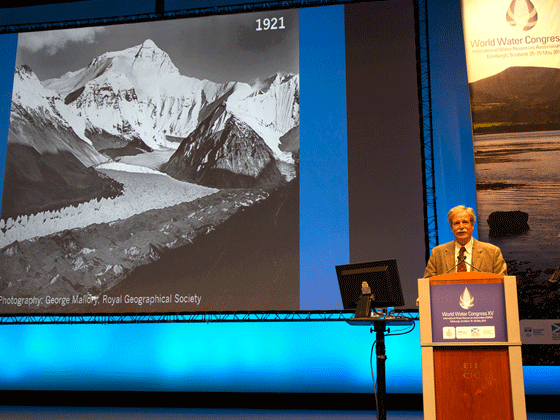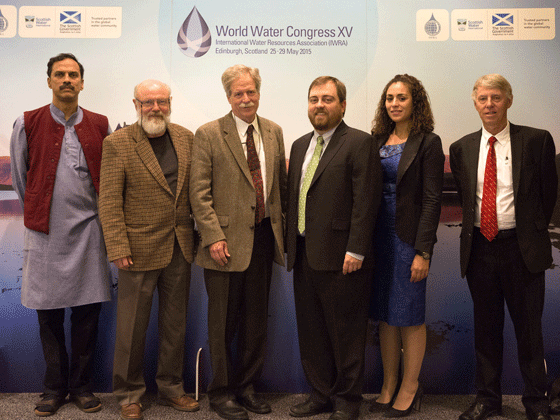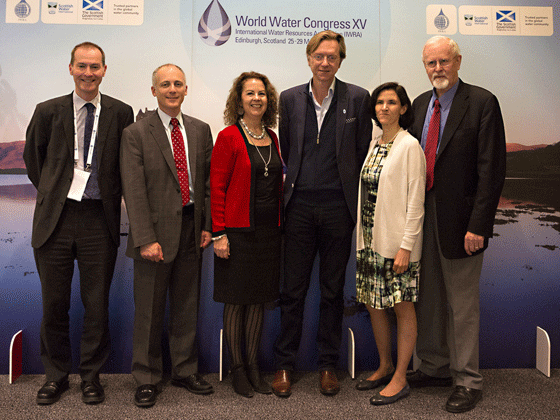The special session on ‘Water and Mountains’ convened by the International Centre for Integrated Mountain Development (ICIMOD) and the Himalayan Adaptation, Water and Resilience Research (HI-AWARE) consortium at the 15th World Water Congress held in Edinburgh, Scotland, from 25 to 29 May 2015, called for more attention on the issue of water challenges in mountains in global water debates and agendas.
Compared to other geographies and water systems, mountain water and governance systems are relatively unknown and receive little attention. The Panel discussed the water challenges in mountain environments, their importance for downstream areas, and the need to mainstream these issues in global water agendas.
 ICIMOD’s Director General Dr David Molden makes his statement at the World Water Congress
ICIMOD’s Director General Dr David Molden makes his statement at the World Water Congress
The Panel, chaired by Director General Dr David Molden of ICIMOD and facilitated by Dr Philippus Wester, Principal Investigator of the HI-AWARE Consortium, discussed various water challenges in mountain environments as well as in the basins, and the need to mainstream these issues in global water agendas.
The first discussion took place around the topic of changing water availability due to climate change, where Dr David Molden highlighted the state of the Himalayan glaciers and their importance to millions of people upstream and downstream. He drew particular attention to water-induced disasters in the region and emphasized on risk reduction and preparedness.
 The ‘Water and Mountains’ session was chaired by Dr David Molden
The ‘Water and Mountains’ session was chaired by Dr David Molden
Dr Molden said spring sources in mid-hills were drying up although there was no concrete evidence as to why this was happening. Is this anthropogenic or is this because of climate change, he asked. Springs are a critical water source to mountain people since water from the glacier-fed rivers often run through deep gorges and ravines and is mostly inaccessible.
Not only did the Fourth Assessment Report (AR4) of the Intergovernmental Panel on Climate Change (IPCC) lack critical data on Himalayan glaciers, it also led to serious controversies when the authors concluded that most glaciers were either already melting or would melt in the coming decades. However, since the launch of AR4, there has been an exciting and lively body of new literature on glaciers from hydrologists and glaciologists. And some of these new studies have said that the annual volume of water will not change even in the face of melting glaciers as rainfall is predicted to increase.
“However, this will would vary between regions, and there are also indications that while some regions will receive heavy rains, others will experience draught, and this could lead to more hazards and disasters,” said Dr Molden. “This will have serious consequences for the hydropower sector.”
On the other hand, mountain areas are places of extreme change with a high degree of poverty. Male out-migration and rapid urbanization are other significant challenges that mountains face. In fact, when one looks across the Hindu Kush Himalayas one sees that on average people in the mountains are poorer than the people in the plains. At the same time, there are opportunities in this context of change, and sometimes change does bring opportunities. “So, if we think about migration, what about the remittances from migration? Can we put that to better use, for environment and livelihoods? Let’s think about different unique mountain products. Can we get that to the market and bring more income to mountain people?” he asked, adding that ecotourism is another area of opportunity for mountains.
 The Panel was facilitated by Dr Philippus Wester (third from the right), Principal Investigator of the HI-AWARE Consortium
The Panel was facilitated by Dr Philippus Wester (third from the right), Principal Investigator of the HI-AWARE Consortium
While water is recognized as a key resource mountains provide to global population, it is just one of many ecosystem services that mountains abound in, said Dr Martin Price of Highlands and Islands University, a renowned voice on mountains. Mountains are also hotspots of bio- and cultural diversity; and they are sacred because they are the watersheds. Unfortunately, according to Dr Martin Price, mountain issues continue to feature huge gaps, especially in terms of data and statistics. For example, spatial interactions of land and people is often not taken into consideration by scholars. Similarly, tourism is spatially uneven and draws people away from subsistence.
He agreed that mountains do abound in opportunities to produce goods, but today many tilling the land are women subsistence farmers, a result of outmigration of men for other lucrative jobs away from rural areas. Mountain areas vary greatly, and therefore, issues may differ between mountains. “Further, there is little data on climate change related to mountains, and most projections are based on limited data, as is often represented by beautiful graphs based on dodgy research that is constantly shifting,” he said, adding that extreme events could be more important than general changes while talking about climate change in relation to mountains. He pointed out the need for upstream-downstream linkages.
In the political realm, Dr Martin Price said, very few mountain countries have significant economic and political power given that mountains generally are part of countries that are far away from key urban areas and thus marginalized.
Talking about his experience from ridge to reef, Professor Torkil Clausen, Chair, Scientific Programme Committee of World Water Week in Sweden, said issues of convergence must be addressed as well. For example, people managing basins hardly interacted with those living by the seas. He said it is important to look at the continuum from hilltop to ocean as one system. Despite fancy concepts like integrated water resource management, people working along the system hardly interacted with each other. “We must see mountains as part of the basin,” Professor Torkil Clausen said.
Professor Asit K Biswas of Lee Kuan Yew School for Public Policy, Singapore, said many basins interconnect, thus the question of scale is important. Giving the example of India’s experience in the management of Brahmaputra and Ganges and the complexities it brought along, he said there is too much generalization in the water field. “Powers of the game are too asymmetrical,” he said. “World doesn’t revolve around water for politicians, and water is a minor issue until there is a disaster.”
